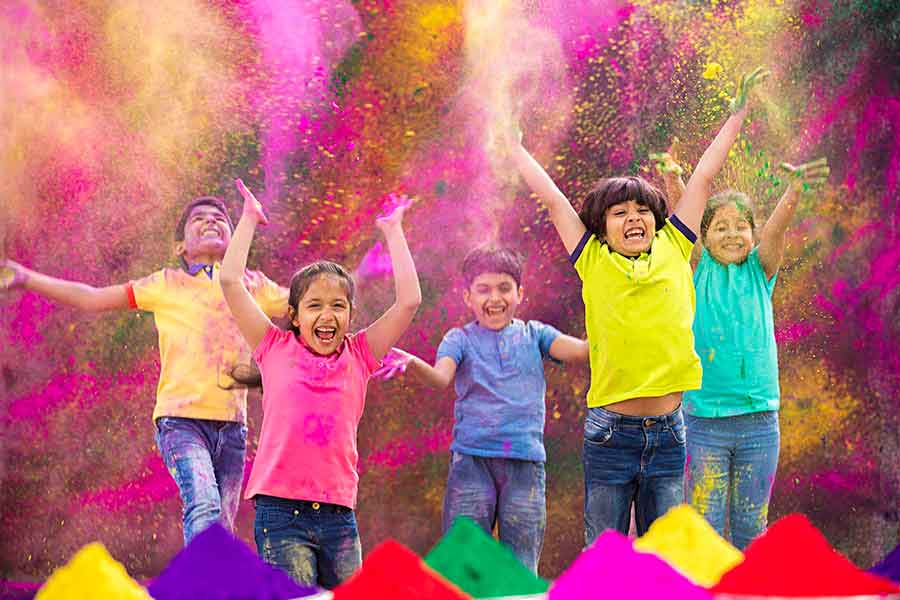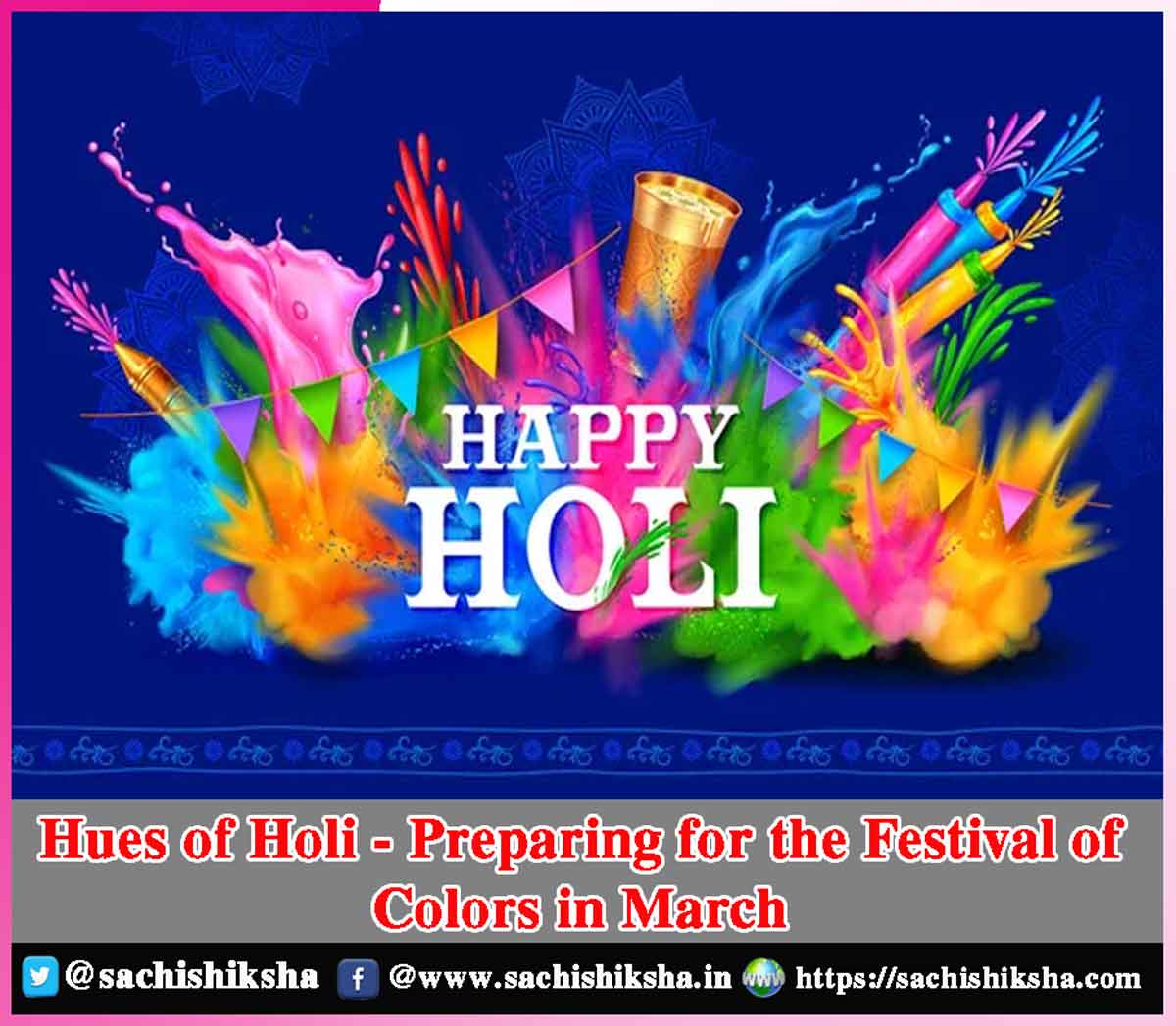Hues of Holi-Preparing for the Festival of Colors in March
Introduction : Holi is one of India’s most beloved and cherished festivals, with celebrations taking place all around the country. It is usually held in March, brings a rainbow of chalk to the streets of India every year.
The Holika bonfire is lit the evening prior Holi, connecting individuals together for an evening of singing and dance. The following day, the bonfire is replaced with a color-filled carnival. The festival’s goal is to bring people together, bringing together rich and poor, men and women, kids and elderly – people who might otherwise not meet. The festival of colors is well-known around the world.
Table of Contents
Festival of Love

The major Indian celebration endures a day and a night, beginning in the evening of Purnima, or Full Moon Day, in the month of Falgun. The first night of the event is known as Holika Dahan or Choti Holi, while the next day is known as Holi. It goes by a variety of names around the country. The brilliance of colors infuses an abundance of happiness into our daily lives, and Holi, getting the festival of hues, is truly a day to celebrate. In the evening, people express their affection and admiration for their loved ones with Abeer.
Holika
Holi is an ancient Indian festival, formerly known as ‘Holika’. The festivities are described in depth in early spiritual works like Jaimini’s Purvamimamsa-Sutras and Kathaka-Grhya-Sutras. Researchers also claim that Holi was celebrated by all Aryans, but particularly in the eastern region of India. It is believed that Holi flourished for centuries before Christ. However, the festival’s significance is thought to have evolved over time. Previously, married women undertook a specific rite to ensure the happiness and health of their families, and a full moon (Raka) was adored.
Paintings on Historic Temples

Radha Krishna Narrative
However, the literal definition of the term ‘Holi’ is ‘burning’. There are several traditions that describe the significance of this name, the most well-known of which is related with demon ruler Hiranyakashyap. Holi also commemorates the narrative of Radha and Krishna, which portrays Krishna’s immense pleasure when putting color on Radha and other gopis. Krishna’s trick eventually became an occurrence and a feature of the Holi festivities.
Holi Legends & Their Holy Messages
According to mythology, Holi commemorates the death of Ogress Pootana, who attempted to kill young Krishna by giving him poisonous milk. Another prominent Holi legend in Southern India is the story of Lord Shiva and Kamadeva. According to mythology, individuals from the south honor the deeds of Lord of Passion Kamadeva, who devoted his life to free Lord Shiva from meditation and preserve humanity.
Other festival tales include those of Shiva and Kamadeva, as well as those of Ogress Dhundhi and Pootana. All show the eventual victory of kindness over evil, adding a philosophical dimension to the holiday. All of these tales inspire people to live virtuously and to hold onto the value of honesty. This is especially vital in today’s world, where so many individuals resort to bad activities for minor advantages and punish those who are honest. Holi encourages individuals to trust in the virtues of truth and honesty while simultaneously combating evil.
Celebrated by One & All
Furthermore, Holi is celebrated during a time of year when crops are in peak condition and people anticipate an excellent crop. This gives individuals a wonderful cause to celebrate, have fun, and immerse into the celebrations of Holi. Holi promotes social cohesion and strengthens our country’s secular foundation. Non-Hindus also celebrate the event because everyone wants to be a part of such a colorful and joyful celebration. Also, according to Holi tradition, even rivals become buddies during Holi and forgot about any hardships they may be experiencing and everyone celebrates the festival in an atmosphere of camaraderie and brotherhood.
Scientific Effect of Colours
Furthermore, when colours are sprayed on the body, they have an enormous effect. Scientists believe that the liquid dye, or Abeer, passes the body and reaches the pores. It strengthens the ions in the body, improving its health and appearance.
Scientific Explanation to Holika Dahan
There is other scientific explanation to celebrate Holi. However it is related to the Holika Dahan ritual. The winter and spring transformation periods promote the development of germs in both the atmosphere and the human body. When Holika is burned, the temperature climbs to approximately 145 degrees Fahrenheit. According to custom, when individuals do Parikrama (circumambulation or traveling around) round the fire, the warmth from the fire destroys the microorganisms in their bodies, purifying them.
Holi Pooja
Ideally, the cheerful festival of Holi is designed to commemorate the approach of spring reflecting the varied hues of the weather. Holi Pooja conducted the day before the Holi Festival. This day is known as ‘Holika Dahan’. There is no specific pooja carried out on Holi Day. This day is exclusively for celebrating and playing with colors. Holika Dahan is the main ceremony conducted during Holi and is regarded an essential Holi Puja.
On the eve of the Holi celebration, people build bonfires to commemorate the triumph of ‘good’ over ‘evil’, known as Holika Dahan. Certain communities do Holi Pooja differently. Marwari women do Holi Puja in the afternoon and evening, prior setting fire to ‘Holika’. It’s called ‘Thandi Holi’. The entire Puja ceremony is viewed as a great blessing for married women.
Thandai
Thandai is closely associated with the Holi festival. When individuals get tired of tossing each other in the pool of colored waters, they enjoy a cooling and healthy drink called thandai. A glass of Thandai provides immediate energy and lays the stage for color experimentation. Furthermore, when mixed with the intoxicating bhang, it can cause one to sing, dance, and go crazy. In reality, bhang thandai is utilized to set the tone for the Holi festival. The thandai culture is very popular in North India. Banaras (now Varanasi) is known as the hub of thandai. This is because Banaras people are known to have a liking for milk-based drinks, and among all the drinks, Thandai is mentioned
Conclusion
However, in today’s world, Holi does not represent all that is wonderful. Holi, like many other celebrations, has become continually advertised, loud, and an indicator of environmental issue. To de-pollute Holi and restore it to its natural state, numerous environmental and social groups are advocating for the switch to simpler methods of celebrating Holi. The purpose of this article is to raise understanding about the numerous negative consequences of Holi celebrations and motivate people to celebrate Holi in an environmentally friendly manner!













































